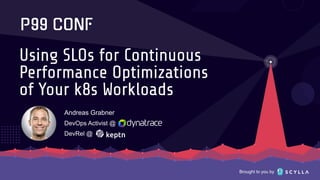
Using SLOs for Continuous Performance Optimizations of Your k8s Workloads
- 1. Brought to you by Using SLOs for Continuous Performance Optimizations of Your k8s Workloads Andreas Grabner DevOps Activist @ DevRel @
- 2. Andreas Grabner DevOps Activist at Dynatrace, DevRel at Keptn ■ Been working in performance engineering for 20+ years ■ Initial focus on performance testing – then observabilty ■ P99s: What impacts them are often very simply things ■ I host a podcast called PurePerformance ■ Away from work you find me salsa dancing
- 4. Distributed Traces are a source of great insights Legacy Micro-services 3rd -party Frontend LB Databases AWS-ELB
- 5. Most common issue I‘ve seen: N+1 Query Issue 26k Database Calls 809 3956 4347 4773 3789 3915 4999
- 6. Same N+1 pattern also for svc-2-svc calls Classical cascading effect of recursive service calls!
- 7. More Common Patterns + Metrics to look at ■ N+1 call: # same Service Invocations per Request ■ N+1 query: # same SQL Invocations per Request ■ Payload flood: Transfer Size! ■ Granularity: # of Service Invocations across End-2-End Transaction ■ Tight Coupling: Ratio between Service Invocations ■ Inefficient Service Flow: # of Involved Services, # of Calls to each Service ■ Timeouts, Retries, Backoff: Pool Utilization, … ■ Dependencies: # of Incoming & Outcoming Dependencies More recorded presentations on problem patterns: • Java and Performance: Biggest Mistake - https://www.youtube.com/watch?v=IBkxiWmjM-g (SFO Java Meetup) • Top Performance Challenges: https://www.youtube.com/watch?v=QypHTQr2RXk (Confitura 2019) • Automatically avoid the top performance patterns: https://www.youtube.com/watch?v=lpDMCTgOzV4 (Performance Summit 2021)
- 8. Keptn to Automate based on SLOs
- 9. Keptn from 10000ft: Declarative, Event Driven Eventing Application Plane (=Process Definition) Define overall process for delivery and operations Control Plane Follow application logic and communicate/configure required services API Site Reliability Engineer DevOps Developer shipyard.yaml - dev: direct, functional, SLO - staging: B/G, perf, SLO - prod: canary, real-user, SLA uniform.yaml config-change*: helm deploy*: JMeter deploy-finish: Lighthouse problem*: Remediation all: Slack, Dynatrace Execution Plane (=Tool Definition) Deploy Service (Helm, Jenkins …) Test Service (JMeter, Neotys, ..) Validation Service (Keptn Lighthouse …) Remediation Service (Keptn Remediation, SNOW …) Config Service (Git, …) Monitoring Service (Prometheus, Dynatrace, …) Artifact / Microservice config.change: artifact:x.y deploy.finished: http://service1 tests.finished: OK evaluation.done: 98% Score problem.open: High Failure remediation.yaml - high-failure-rate: - scaleup, rollback - full-disk: - cleandir;adjustlog-level
- 10. Keptn: Automate pattern analysis through SLOs Instead of manually test execution and report based analysis 1 2 3 4 1 2 3 4 x 1 2 3 4 x automates test execution and SLO-based evaluation X ~30-60min ~1min CD P E R F O R M A N C E as Self - Svc
- 11. Example: Speeding up GitLab Pipelines by 80% Christian Heckelmann Senior DevOps Engineer 87.5%: passed Automated SLI/SLO based Quality Gates Trigger Evaluation Pull SLI Metrics
- 12. A closer look at SLO Validations Overall Failure Rate Query: builtin:service.errors.total Test Step LOGIN Response Time Query: calc:service.teststeprt:filter(Test, LOGIN) Test Step LOGIN # Service Calls Query: calc:service.testsvc:filter(tx, LOGIN) <= 5% <= 2% <=150ms & <=+10% <= 400ms <= +0% Build 1 0% 80ms 100ms SLO: Overall Score Goal 90% 75% Response Time 95th Perc Query: builtin:service.responsetime(p95) <=100ms <= 250ms SLO SLIs (Service Level Indicators) warn pas s 1 100% Build 2 4% 120ms 90ms 2 50% Build 3 1% 90ms 120ms 1 70.0% Build 4 0% 95ms 95ms 1 100% Build 1 Build 2 Build 3 Build 4 $ keptn send event start-evaluation myproject myservice starttime=build1_deploy endtime=build1_testsdone $ keptn send event start-evaluation myproject myservice starttime=build2_deploy endtime=build2_testsdone $ keptn send event start-evaluation myproject myservice starttime=build3_deploy endtime=build3_testsdone $ keptn send event start-evaluation myproject myservice starttime=build4_teststart endtime=build4_testsend Open Security Vulnerabilities Query: calc:secproblems:filter(risk,CRITICAL) <=0 0 0 1 0
- 13. Behind the scenes: How SLO Evaluation works sli.yaml (Dynatrace) indicators: error_rate: "builtin:service.errors.total.count" count_dbcalls: "calc:service.toptestdbcalls" jvm_memory: "builtin:tech.jvm.memory.pool.committed" sec_critical: "calc:secproblems:filter(risk,CRITICAL)" slo.yaml (SLI Provider independent) objectives: - sli: error_rate pass: - criteria: - "<=1“ # We expect a max error rate of 1% - sli: jvm_memory - sli: count_dbcalls pass: - criteria: - "=+2%" # We allow a 2% increase in DB Calls between builds warning: - criteria: - "<=10" # We expect no more than 10 DB Calls per TX - sli: sec_critical pass: - criteria: - "<=0" # We do not allow any critical security issues total_score: pass: "90%" warning: "75%" sli.yaml (Prometheus) indicators: error_rate: "http_requests_total{status=“error"}" jvm_memory: "jvm_memory_used_bytes{area="heap"}[1m]" sec_critical: "rate(falco_events[5m])" SLI Providers: Query SLIs based on sli.yaml and return individual values Lighthouse Service: Retrieves SLIs and compares them against SLOs ... *get-sli* *evaluation* count_dbcalls : 5 jvm_memory: 360MB error_rate: 4.3% sec_critial: 1
- 14. triggers an automation sequence orchestrates monitoring config, deployment, test execution, SLO evaluation & remediation You Pick: SLOs, Testing or E2E-Automation
- 15. Keptn in the real world!
- 16. Release Readiness for Austrian Online Banking #1 List of release relevant SLOs #2 Total SLO Score per evaluation #3 Link back to Jenkins https://medium.com/keptn/keptn-automates-release-readiness-validation-for-austrian-online-banking-software-eaaab7ad7856
- 17. Automated Performance Test Analysis https://www.youtube.com/watch?v=6vd8rtcoV9k&list=PLqt2rd0eew1YFx9m8dBFSiGYSBcDuWG38&index=5&t=2s
- 18. Multi-Tenant Environment Stability Validation https://medium.com/keptn/validating-environment-stability-with-keptn-c07de8293486
- 19. Keptn recognized by performance engineers
- 20. Let’s Wrap it up!
- 21. Automate Distributed Problem Detection & Remediation #1 Understand your Patterns & Define Metrics #2 Monitor your metrics (SLIs/SLOs) #3 Let Keptn automate the analysis #4 Integrate Keptn into Delivery & Operations
- 22. Want to learn more about Keptn? https://www.youtube.com/watch?v=wmP9FI6tHtg&list=PL2KXbZ9-EY9TWsV-Jz8ARSt1ko0Yd36ah&index=31 https://www.youtube.com/watch?v=_j50rleFjHA
- 23. New community members welcome! Star us @ https://github.com/keptn/keptn Follow us @keptnProject Slack Us @ https://slack.keptn.sh Visit us @ https://keptn.sh
- 24. Brought to you by Andreas Grabner andreas.grabner@dynatrace.com @grabnerandi
